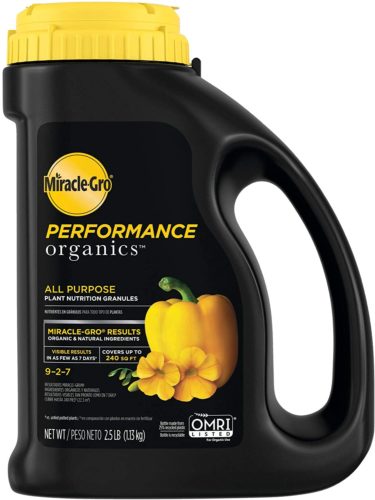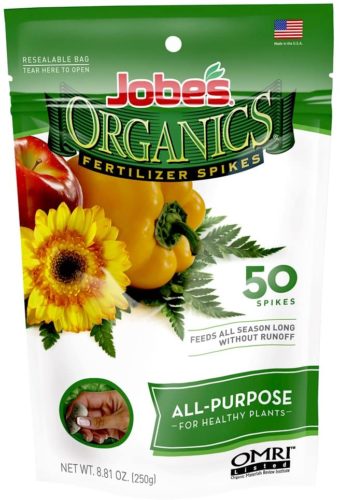Lettuce is one of the easiest vegetables to grow, and it’s also one of the fastest to reach maturity, after radishes and small turnips. Lettuce is also a relatively light feeder – it doesn’t need high amounts of fertilizer.
That said, lettuce grows very quickly in the presence of fertilizer. You can even try it yourself by leaving a few lettuce heads unfertilized and see the difference.
Any balanced, all-purpose fertilizer will suffice for lettuce, and any that have more nitrogen (higher N value in the NPK numbers) will promote faster, more lush growth. There aren’t really any “lettuce fertilizers” on the market in the same way that there are tomato fertilizers or grass fertilizers. Most of the fertilizers below are simply all-purpose fertilizers, but have some features which make them particularly good for growing lettuce.
On this page:
List of Fertilizers for Lettuce
Summary
|
Lettuce Fertilizer |
NPK |
Type/Notes |
|
4-4-4 |
Organic, Contains Beneficial Microbes |
|
|
3-2-2 |
Organic, Plant-based |
|
|
4-4-4 |
Organic, Granular, Contains Beneficial Microbes |
|
|
|
2-3-1 |
Organic, Liquid Feed |
|
12-4-8 |
Hybrid Organic, Granular |
|
|
4-4-4 |
Organic, Granular, Contains Beneficial Microbes |
|
|
24-8-16 |
Liquid Feed |
|
|
4.5-2.5-6.0 (approx.) |
Organic, Liquid Feed, Good for Soil and Hydroponics |
|
|
|
9-2-7 |
Organic, Granular |
|
4-4-4 |
Organic, Fertilizer Spikes |
1. Dr. Earth Premium Gold All Purpose Fertilizer
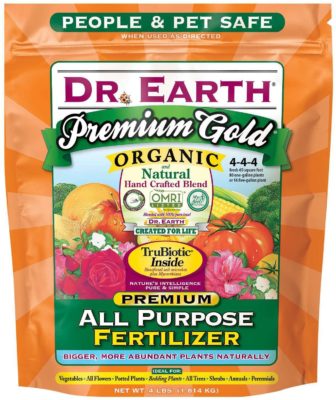
- 4-4-4 NPK
- Continuous Release
- Fast Acting (if made into fertilizer tea)
- Organic
- Contains Beneficial Microbes
A gentle, well-balanced fertilizer, Dr. Earth Premium Gold All Purpose Fertilizer is one of the best commercially available organic options for the home gardener. The reason is because it’s one of the few brands of commercial fertilizer inoculated with beneficial bacteria and fungi.
Beneficial microbes break down organic matter and some beneficial fungi make a mutually beneficial association with plant roots, greatly increasing your plants’ ability to take up water and nutrients. For lettuce, this is even more important because lettuce is a very fast-maturing vegetable, and giving an extra boost of beneficial microbes right where your lettuce will grow means it will reap these benefits much more quickly.
Besides beneficial microbes, Dr. Earth fertilizer is 100% organic, deriving its main nutrients from natural sources like alfalfa meal, fishbone meal, and feather meal. It also includes humic acids which are normally found in compost, and also increase the ability of your lettuce to absorb nutrients.
With an NPK of 4-4-4, there is no risk of burning your lettuce plants if used as directed, and it has all the macronutrients and micronutrients lettuce needs to thrive. In fact, Dr. Earth Premium Gold All Purpose Fertilizer can be used for all your vegetables, although they have better options for tomatoes, peppers, and other heavy feeders.
You can also use Dr. Earth fertilizers to make a fertilizer tea for a more fast acting nutrient feed.
How to apply: You can apply Dr. Earth every other month throughout the growing season. Before planting: Mix 1 1/3 cups for every 10 sq ft of soil, or 6 cups per 50 ft row. If planting lettuce in a container, mix 2 tablespoons per gallon of potting soil beforehand and mix in thoroughly, then water. For established lettuce plants: Mix 1 cup for every 10 sq ft of soil, or 3 cups per 50 ft row. For container lettuce, apply 2 tablespoons per 6 inches of pot diameter (e.g. 4 tablespoons for a 12-inch pot) and gently work into the top inch or two of potting mix, then water.
2. Down to Earth Organic Vegan Fertilizer Mix
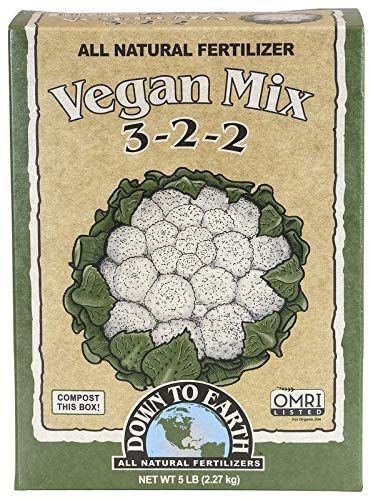
- 3-2-2 NPK
- Continuous Release
- Organic
- Vegan (No Animal Ingredients Used)
Previously, if you wanted to use animal-free fertilizer, you had to mix and match different kinds of fertilizers to get something balanced. But now we are starting to see more choices for vegan-minded gardeners.
Down to Earth, which has a wide selection of natural organic fertilizers, had the presence of mind to develop what I’d call a “full spectrum” plant-based fertilizer, which is derived from a mix of plant-based ingredients such as soybean meal, alfalfa meal, kelp meal, supplemented with minerals like rock phosphate and greensand. Down to Earth Organic Vegan Fertilizer Mix also has humic acids, which are important to help plants take up nutrients. There are no animal products or by-products in this fertilizer.
The NPK is 3-2-2, which is low enough not to burn lettuce roots if used as directed, but has the right ratio for leaf growth, plant metabolism, and a strong root system. The result is a robust, organic, vegan fertilizer for all plants, but especially for leafy green vegetables like lettuce.
How to apply: Can be applied once a month during the growing season. For lettuce transplants: Add 1 to 2 tablespoons per hole and mix into the soil, then water. For established lettuce plants in ground or in containers: Sprinkle fertilizer around your lettuce plants, 2 to 4 tablespoons, and work into the soil.
3. Jobe’s Organics All Purpose Granular Fertilizer
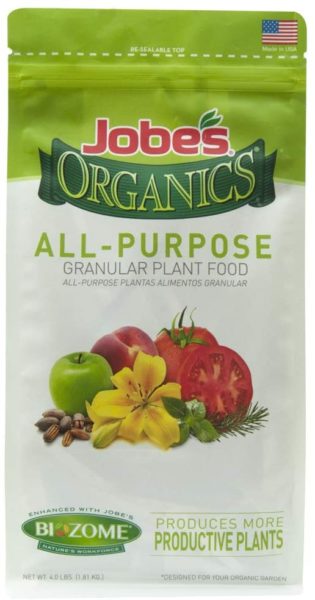
- 4-4-4 NPK
- Fast Acting and Continuous Release
- Organic
- Contains Beneficial Microbes
An established name in fertilizers, soil amendments, and other gardening supplies, Jobe’s now has a full line of organic fertilizers with a patented formula of beneficial microbes, and the most well-balanced for lettuce cultivation is Jobe’s Organics All Purpose Granular Fertilizer.
Similar to Dr. Earth’s fertilizers, Jobe’s Organics fertilizers come inoculated with beneficial microbes. But Jobe’s Biozome includes not only beneficial fungi and bacteria, but also archaea. Without getting too deep into the science, archaea look similar to bacteria, but have much more diverse metabolic pathways, and can break down material that most bacteria can’t, such as minerals. Archaea are therefore an important part of soil ecology, making up to 10% of all soil microbes, and are an integral part of healthy, fertile soil.
All ingredients in Jobe’s Organics All Purpose Granular Fertilizer come from renewable and sustainable and organic sources. In fact, the only ingredients besides beneficial microbes are feather meal, bone meal, processed poultry manure (fresh chicken manure has to be composted or aged before it can be used as a fertilizer), and sulfate of potash.
With a 4-4-4 NPK, this can be used for all your vegetables, flowers, trees, and houseplants, but is excellent as a lettuce fertilizer.
For an even more continuous release version, look into using Jobe’s Organics All Purpose Fertilizer Spikes, which is also 4-4-4 but compressed into spikes which can feed your lettuce for up to two months.
How to apply: Can be used every 4 to 6 weeks during the growing season. For preparing soil: Mix 1 1/2 cups per 10 ft row before planting, or 1.5 tablespoons in the soil for each lettuce transplant, or 1.5 tablespoons for a 16” diameter pot. For established lettuce plants: Apply 1 1/2 cups per foot of lettuce diameter, around just beyond the outer leaves, and mix into the top inch or two of soil, then water in.
4. Neptune’s Harvest Organic Hydrolized Fish & Seaweed Fertilizer
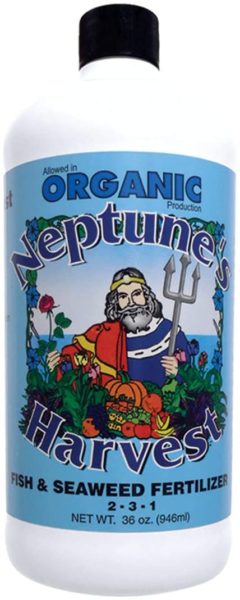
- 2-3-1 NPK
- Liquid Feed
- Fast Acting
- Organic
For those looking for an organic alternative to conventional liquid fertilizers, a tried-and-true fertilizer is fish emulsion, which is made whole or leftover scraps of fish (blood, guts, bones, and all) that have been pulverized into a potent emulsion. We can call this the modern-day version of traditional Native American method of burying fish where vegetables are planted.
However, Neptune’s Harvest Organic Hydrolized Fish & Seaweed Fertilizer is technically not a fish emulsion, but rather hydrolyzed fish, which means the fish have been processed into a fully liquid form. This makes it a fast acting liquid feed that quickly boosts lettuce growth. This fertilizer is also blended with seaweed, giving a balanced nutrient profile to an already powerful organic fertilizer.
You should always dilute Neptune’s Harvest Organic Hydrolized Fish & Seaweed Fertilizer; in its concentrated form, it will have a very strong fishy smell. 4- and 5-star customer reviews note that upon opening the container, there’s an incredibly strong aroma, but when diluted and used in the garden, there is very little smell.
How to apply: Apply every 1 to 2 weeks and always shake well before using. Mix 1 oz (1/8 cup) per gallon of water and apply until the soil is saturated. Foliar feeding (i.e. spraying fertilizer directly on the leaves) is not necessary, but if you want to foliar feed your lettuce to quickly resolve a deficiency, do it in the evening or very early morning, using a mist sprayer on the top and bottom of the leaves. Avoid foliar feeding when temperatures are above 80°F (27°C).
5. Miracle-Gro Shake ‘N Feed All Purpose Plant Food
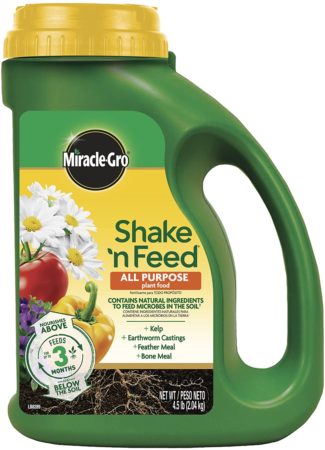
- 12-4-8 NPK
- Continuous Release and Fast Acting
- Hybrid Organic
Miracle-Gro’s Shake ‘N Feed line of fertilizers are not only easy to use, but have the perfect nutrient ratio for growing lettuce. As a hybrid organic granule fertilizer, it also gives the best of both worlds: nutrients are immediately available for lettuce to take up but the organic components break down slowly to continually feed for up to 3 months.
The organic ingredients are derived from kelp, earthworm castings, feather meal, and bone meal. Besides the main nutrients of nitrogen, phosphorus, and potassium, it also has calcium, which is important for strong cell walls as your lettuce grows, magnesium, which is necessary for photosynthesis, and essential micronutrients like iron, zinc, and manganese.
While this is labelled as an “all purpose” fertilizer, its NPK value of 12-4-8 is ideal for growing fast-growing leafy greens like lettuce. Nitrogen (the first number) is crucial for leaf growth, while phosphorus and potassium are more important for fruit/root development and overall plant health.
If you prefer a 100% organic alternative, try Miracle-Gro Performance Organics All Purpose Plant Nutrition Granules, which has a comparable NPK of 9-2-7 and is certified organic.
How to apply: Shake dry fertilizer granules evenly around the plant, avoiding touching the stem or leaves, around 1 tablespoon per square foot (package includes an illustration). You can also mix it into potting mix before planting container lettuce. After applying it, work it into the top 1 to 3 inches of soil and water. It should continue feeding your lettuce for up to 3 months.
6. Burpee Natural Organic All Purpose Granular Plant Food
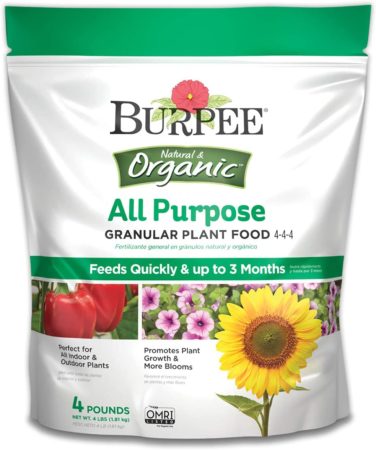
- 4-4-4 NPK
- Fast Acting and Continuous Release
- Organic
- Beneficial Microbes
As a trusted brand for over 144 years, Burpee is mostly known as a seed company, but they also produce their own fertilizers and soil amendments. While their Burpee Natural Organic All Purpose Granular Plant Food is not as popular as other brand names, their near century-and-a-half experience in cultivating vegetables for seed production means they understand what exactly plants need to thrive.
Their 4-4-4 formula is balanced for all vegetables but is naturally good for growing lettuce. It’s a fully organic fertilizer that is gentle enough to not burn lettuce roots if used as directed. It also comes inoculated with beneficial bacteria to promote a balanced soil ecosystem for your lettuce plants. Soil life is critical for growing healthy vegetables, as it is responsible for breaking down organic material while also forming associations with plant roots to help plants absorb nutrients and water more effectively.
Burpee even comes with a 3-month guarantee from purchase, which is more than enough time to try it on lettuce, which fully matures in 50 to 80 days.
How to apply: Burpee granular plant food can last up to 3 months before being applied again. Always water thoroughly after applying. For seed starting: Mix 1/2 cup per cubic foot of seed starting mix. For lettuce planted in the ground: Apply 1 cup for every 10 feet of row length and gently work into the top inch or two of soil. For lettuce grown in containers: Mix 1 cup per cubic foot of soil.
7. Miracle-Gro Water Soluble All Purpose Plant Food
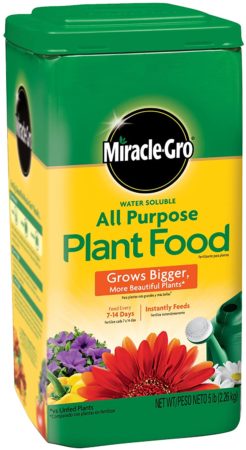
- 24-8-16 NPK
- Liquid Feed (after dissolving)
- Fast Acting
Miracle-Gro Water Soluble All Purpose Plant Food sets the standard for liquid feed in terms of accessibility, ease of use, and fast acting effectiveness. While not organic, this conventional liquid feed is formulated with all the key nutrients and micronutrients for all plants and should be included in the list.
Unlike other liquid fertilizers in this list, this one is technically sold in a solid crystal form, but must be dissolved in water and fed to your lettuce like a liquid feed. The high amount of nitrogen in Miracle-Gro’s formula is perfect for growing lettuce and other leafy greens, but it has enough phosphorus and potassium for other vegetables in your garden as well. And Miracle-Gro’s liquid plant food is formulated with important micronutrients like calcium, manganese, iron, sulfur, boron, molybdenum, and zinc, so it’s a full spectrum fertilizer that doesn’t require other additional nutrients.
Although I personally prefer other fertilizers, I always have Miracle-Gro on hand to give my vegetables a quick boost or to resolve a major nutrient deficiency.
If you prefer organic liquid fertilizer alternatives, try Neptune’s Harvest Organic Hydrolized Fish & Seaweed Fertilizer or Urban Farm Fertilizers All-Purpose Vegetable Fertilizer, both also listed in this article.
How to apply: Apply every 1 to 2 weeks. Mix 1 1/2 tablespoons per 1 1/2 gallons of water and soak the soil around your lettuce plants. You can also use it to feed young lettuce seedlings, but don’t soak the soil. I like to use quarter strength to half strength Miracle-Gro for very young seedlings. After the young plants get established with multiple leaves, use the recommended amount.
8. Urban Farm Fertilizers All-Purpose Vegetable Fertilizer
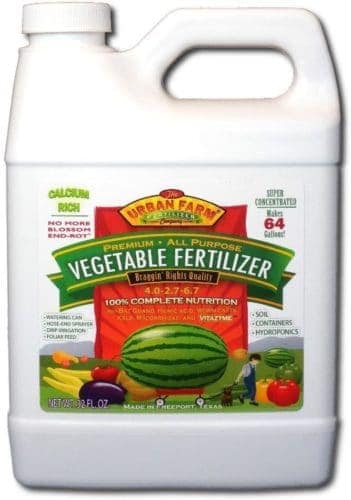
- 4.5-2.5-6.0 (approximate) NPK
- Liquid Feed
- Fast Acting
- Organic
- Good for Soil, Potting Mix, and Hydroponics
Urban Farm Fertilizers has a series of liquid fertilizers that are developed to maximize yields for professional growers, all made with organic components. Their greenhouse-grade plant food is formulated to provide all the major macronutrients and micronutrients for all vegetables and flowers, but is especially good for lettuce.
Urban Farm Fertilizers All-Purpose Vegetable Fertilizer is both organic and has beneficial microbes. It’s inoculated with beneficial bacteria and fungi which will break down the organic ingredients even faster after application. It also includes a full spectrum of minerals, humic acids, and enzymes. You can even use Urban Farm Fertilizers for hydroponic lettuce.
Reviews for Urban Farm Fertilizers All-Purpose Vegetable Fertilizer are overwhelmingly positive, with customers raving about bigger harvests in their gardens after using it.
Urban Farm Fertilizers regularly modifies their fertilizer ingredients, so the 4.5-2.5-6.0 NPK figure is based on the latest updated formula. One thing to note that this liquid fertilizer must be diluted, as it’s in a highly concentrated form (256:1). A 1 quart bottle will make 64 gallons of liquid feed.
How to apply: Mix 1 tablespoon (1/2 oz) per gallon of water. Water your lettuce with the diluted fertilizer solution. Like other liquid fertilizers, you can apply it every 1 to 2 weeks during the growing season.
Related Questions About Fertilizing Lettuce
What Is NPK? What Do the Numbers Mean?
NPK refers to the percent-by-weight of each of the three most important elements plants need: Nitrogen (N), Phosphorus (P), and Potassium (K). So, a 4-4-4 fertilizer consists of 4% of each of those three nutrients by weight. Plants also require a lot of other nutrients in smaller amounts, and I have already gone into more detail about plant nutrients with references for each nutrient if you want to read more.
How Often Should I Fertilize Lettuce Plants?
In general, liquid fertilizers should be applied every 1 to 2 weeks during the main growing season. Fertilizer spikes or granules that are slow/continuous release are applied much less frequently. It depends on the specific brand, but it can range from every 4 weeks to 3 months.
Can I Feed Lettuce Plants with Blood Meal?
Yes. Blood meal is actually an excellent fertilizer for lettuce because it has very high nitrogen. It’s actually the highest natural source of nitrogen you can use as a fertilizer. If you are growing in regular garden beds or pots with compost, you can just use blood meal to give an extra nitrogen boost.
There are plenty of brands of blood meal, and there isn’t much difference between them in terms of nutritional value for your lettuce, and the NPK of blood meal is generally around 12-0-0. Some examples below:
What Is Foliar Feeding? Can I Foliar Feed Lettuce?
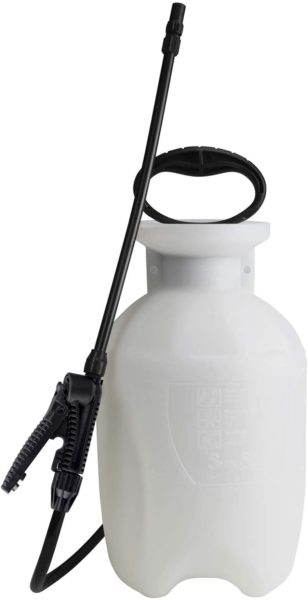
Foliar feeding means applying a liquid fertilizer to the leaves of your plants. A lot of nutrients can be absorbed through the leaves, so this can be a quick way to boost the growth of your lettuce or resolve a deficiency.
You can certainly foliar feed lettuce, but depending on the fertilizer, I would not apply it within at least a few days to a week before harvest, especially if you’re using strong-smelling liquid feed like hydrolyzed fish fertilizer. That will give it enough time to be absorbed and the excess can naturally wash off the leaves and into the soil before harvest.
Always follow the directions of whatever liquid fertilizer you’re using and apply late in the evening or early in the morning. You can use a mister or if you have a lot of plants to foliar feed, you can use a hand-pumped garden sprayer. Chapin is a popular brand and you can reuse it for foliar feeding and organic pesticide and fungicide sprays.

